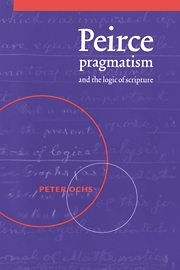Book contents
- Frontmatter
- Contents
- List of abbreviations
- PART I Peirce's pragmatic writing
- 1 Introduction: reading Peirce's pragmatism
- 2 Pragmatic methods of reading and interpretation
- 3 Problems in Peirce's early critique of Cartesianism
- 4 Problems in Peirce's early theory of pragmatism
- 5 Problems in Peirce's normative theory of pragmatism, 1878–1903
- 6 A pragmatic reading of Peirce's lectures on pragmatism
- PART II Peirce's pragmaticist writing
- Notes
- Index
2 - Pragmatic methods of reading and interpretation
Published online by Cambridge University Press: 22 October 2009
- Frontmatter
- Contents
- List of abbreviations
- PART I Peirce's pragmatic writing
- 1 Introduction: reading Peirce's pragmatism
- 2 Pragmatic methods of reading and interpretation
- 3 Problems in Peirce's early critique of Cartesianism
- 4 Problems in Peirce's early theory of pragmatism
- 5 Problems in Peirce's normative theory of pragmatism, 1878–1903
- 6 A pragmatic reading of Peirce's lectures on pragmatism
- PART II Peirce's pragmaticist writing
- Notes
- Index
Summary
This is a technical chapter, for specialists in epistemology. General readers may prefer to move ahead to chapter 3, to take up the actual story of Peirce's intellectual struggles. This chapter addresses concerns the epistemologist may have about how I go about telling this story. Am I presenting an intellectual biography or a philosophic analysis? Why have I chosen this method of analysis? How are my claims about the development of Peirce's thought warranted? In responding to these questions, I will describe a pragmatic method of reading and interpreting a modern philosopher's writings. The rest of the book should exemplify the method, as applied to Peirce's writings. I argue that this method is a token of Peirce's pragmaticism, but I will be able to defend my argument only at the end of the book, after having performed it. In other words, this study itself belongs to what I will label a Method of Interpretation and Repair: which is to interpret a philosopher's thought according to a critically refined principle of his or her own thinking.
Pragmatic reading in the Cartesian–Kantian tradition of epistemology
Peirce addressed his writings on pragmatism primarily to communities of epistemologists. In this chapter, I also describe the pragmatic method of reading primarily in the language of what I call the Cartesian–Kantian tradition of epistemology. Peirce presented his earliest work in pragmatism as a critique of what he called “Cartesianism” and as a revision of Kant's critical philosophy.
- Type
- Chapter
- Information
- Peirce, Pragmatism, and the Logic of Scripture , pp. 20 - 50Publisher: Cambridge University PressPrint publication year: 1998

